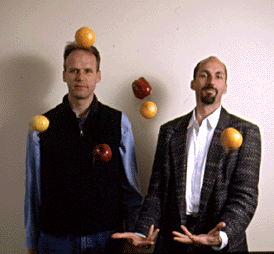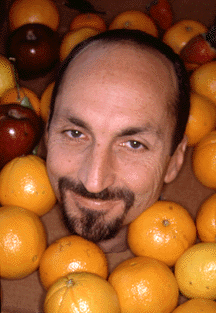Photo by Christopher GardnerWizards of Od: Odwalla joint CEOs George Steltenpohl and Steve Williamson have whipped up success from a unique blend of freshly squeezed juice, savvy marketing and rapid delivery.
Odwalla founder Greg Steltenpohl and his partners were looking for a business that allowed them to respect the earth, nourish the body and stay within spitting distance of the ocean. The secret was in a glass of fresh juice: no preservatives, no polluting, no processing, just the real thing.
By Christina Waters
A soothing expanse of blue ocean is on permanent display outside Greg Steltenpohl's window. Playing counterpoint to this azure backdrop are the contents of his desk. The Odwalla founder's 8-year-old son, Eli, smiles up from a photograph taken somewhere in the snow. A produce label--Pescadero Peas, once packed in this very room--sits framed on a Guatemalan textile. A small African carving, a bottle of Odwalla geothermal spring water, a few promotional posters are scattered about. There's a trio of plaques commemorating Odwalla's stock offering on NASDAQ: "one million shares--May 18, 1995."
Each item--including the phone, fax and Rolodex on the far edge of the desk--is imperceptibly aligned with the sea. The origins of Odwalla are as much about this physical site--the need to stay connected to the primal liquid--as they are about entrepreneurial edge.
Juice Do It:
Ten years ago, the juice company with the funny name had 40 employees working in a former broccoli packing shed in Davenport. Today there are 600. A product line of almost 30 fresh specialty fruit and vegetable juices is distributed daily to 2,500 locations throughout the West, bursting out of the natural foods market to include 7-Eleven, Starbucks and Safeway. The socially responsible darling of environmental watchdogs, Odwalla is regularly honored for its pioneer recycling, organic cultivation and community investment programs--most recently by Business Ethics Magazine for "Outstanding Corporate Environmentalism."
Odwalla's vision not only honors the planet, it also cultivates the bottom line. The 15-year-old company's sales have doubled each of the past three years and are projected to reach the $50 million mark by the end of 1996.
Steltenpohl now drives back and forth to Davenport--where all Odwalla juice was pressed, packaged and distributed for ten years--from the new corporate headquarters in Half Moon Bay. Two years ago, the juice-making operation was moved to a 65,000-square-foot facility in Dinuba, a very un-coastal location in the Central Valley strategically located in the midst of the orchards that fuel Odwalla's products. The original headquarters remains a distribution point, as well as a sanctuary for product development and design. Here's where the "Drink Tank" is housed, where Odwallians conduct brainstorming sessions that results in company epigrams like "Drink It & Thrive," which bear an unmistakable family resemblance to such Star Trek directives as "Live long and prosper." This is also where inspiration is spun into the playful graphics, the bouncing fruit, the vibrating palm trees, the neon-hued signifiers of Odwalla fecundity, along with names like Mango Tango, Menage a Tropique, Mo'Beta and Femme Vitale. These playful bits of organic eye candy are key elements in what Steltenpohl calls "the conversation," the dialog that is Odwalla's intimate marketing link with the consumer, many of whom never imagined themselves shelling out $2.50 a bottle for anything but a good beer.
$200 and a Shed
In 1980, Greg Steltenpohl was happily entrenched in the prevailing Santa Cruz culture. He'd come from Southern California to major in environmental studies at Stanford. Like so many others, Steltenpohl, live-in girlfriend (and later, wife) Bonnie Bassett and childhood buddy Gerry Percy played around with Santa Cruz's ubiquitous music scene, when they hatched a plan for their "day job." Armed with a $200 loan from Bassett, the guys started squeezing oranges in the shed behind Steltenpohl's Seabright Avenue house, taking the name "Odwalla" from the visionary hero in a favorite musical piece.
"We were a loose-knit group of friends, looking for a legal way to make a living together," Steltenpohl recalls with a laugh. A calm, dark-haired 41-year-old with an easy smile, Steltenpohl readily allows words like "mantra," "vision" and "primal substance" to pepper his conversation. His supple suede jacket seems a laid-back yet sartorially correct nod to adult business attire.
"In the early days, I had a lot of discussion with people in the natural foods community," says Steltenpohl. Sharing that discussion were fellow alternative entrepreneurs who'd begun similar businesses from the ground up-- Wildwood Natural Foods co-founder Paul Ohrbach, Ron Madden, who sold fresh carrot juice at his Santa Cruz Juice Club and Arty Mangan, who pressed fresh apple juice at his Corralitos-based Live Juice.
All of them are now with Odwalla.
"This is what's unique about the company," says Steltenpohl. "We've been able to attract people who are entrepreneurs in their own right, and create an environment where they can flourish." That ability to stay flexible separates Odwalla from the big companies, many of whom "are giving up on the idea that they are going to be entrepreneurial."
Steltenpohl prefers the metaphor "conversation"--instead of "idea" or "product"--to describe the intellectual energy that fuels Odwalla. "The original conversation was that a great bottle of juice was as good as something you could squeeze yourself in the kitchen." Steltenpohl grins. "What's the focus of the company? It's that conversation that happened when you tasted it for the first time. That wasn't just orange juice, it was, 'Wow it tastes better than anything I've ever had before.'"
Soil to Soul
In trying to preserve the "wow," yet still meet "huge, restrictive deadlines" involved in moving a highly perishable product, Odwalla has put MTV spin on the idea of delivery. "Our company is a Federal Express-type operation," explains Steltenpohl. "We're taking hundreds of thousands of orders every week from all our outlets."
Those orders are delivered by drivers/sales reps who stock the familiar, multi-colored end-aisle coolers where Odwalla juices hum and throb in their own specially regulated climate.
Odwalla route drivers--the key link in the company's "soil to soul" philosophy--deliver to Costco, to corporate dining rooms at Netscape and Apple, and to Hispanic consumers in San Jose and Watsonville raised in a culture that prizes fresh juices as much as yuppies do.
Deliveries, as well as outdated stock that needs to be removed, are tracked on Odwalla's Silicon Valley-designed hand-held computers that "hold a memory of every SPU [single product unit] sold," says Steltenpohl. "So there's this huge information management thing and if you screw it up, the juice blows up," Odwalla's main squeeze chuckles. "Or the shelf is empty and everyone's upset."
Steltenpohl begins to impress even himself with just how complex this business of fresh juice delivery really is. "And at the same time, we're not Coca-Cola," he says. "We can't inventory some giant warehouse with all this stuff in it--this has to be juiced. Then to juice it you have to have pulled all the stuff out of the ground just in time so it gets to the plant while it's fresh. So the number of variables going on is huge."
Steltenpohl invites me to consider everything he's said and then tell him that at $2 per 16 ounces Odwalla is anything but a rock-bottom bargain. But Odwalla isn't going to all this trouble just to be liked. "We hope that our position of investing in all this pain-in-the-ass stuff, this Federal Express operation," says the CEO, "ultimately protects us against the Cokes and Pepsis of the world when we show up over the $100 million mark--which is when they'll start wanting to have a piece of the action."
Going with the Flow
Steltenpohl cops to a certain tension between Odwalla's casual, natural mission to "nourish the body whole" and the realities of large-scale success. Though the company encourages the active conceptual participation of its entire community of workers, this is not a do-your-own-thing enterprise. "It's a business," Steltenpohl states emphatically. "We get up early."
Steltenpohl won't reveal the actual structure of the Odwalla corporation--"That's a corporate secret, part of the key to our competitive success." But he will acknowledge the lack of the typical America top-down hierarchical organization. Odwalla is a flat, horizontally cross-pollinated company where the reigning metaphor of "conversation" isn't just New Age fuzzy logic. It's how decisions are made concerning the next idea being developed, how product names are determined--for which worldwide brainstorming session are often held.
It also is how visual presentation is shaped. Steltenpohl happily displays file folders overflowing with notes, doodles, drawings and correspondence all chronicling the evolution of a new product label--an impressive pedigree of graphic brainstorming that has spanned two continents and two years.
"The company is structured as a partnership--we have a sort of office of the president, which Steven Williamson and I chair," Steltenpohl admits, resorting to an analogy of Saturn and its rings to describe the in-house information flow from vision to drawing board to organic cultivation to delivery.
Several concessions to marketplace numbers have been made in recent years. Odwalla brought in a financial manager--investor and current co-CEO Williamson--in 1991, who helped trim some staff flab and engineered the cost-effective move of production to Dinuba. The Initial Public Offering on the stock market in 1993 raised needed capital. Increasing numbers of neighborhood nodes--enabling juices to be distributed more efficiently to an increasingly far-flung market--have emerged in the past few years. And the acquisition in 1995 of Denver's Just Squeezed Juices and Dharma Juice in Bellingham, Wash., provided ready-made platforms for further Odwalla launches.
"Yes, it's growing, but at the same time it's getting smaller," says Steltenpohl, characteristically stretching concepts in order to make them do the creative work his conversation requires. "We used to have 60 trucks going out of one location. Now there are neighborhood nodes, with six to eight trucks."
A Dip in the Drink Tank
When they first entered the multi-million-dollar juice market 13 years ago, workers in the Davenport facility could watch the Pacific waves as they pressed juice in a tiled room. Steltenpohl reverently refers to it as the Water Temple, his face mirroring the crazy thrill of those early days as he gazes at the same view.
Climbing some carpeted stairs, walking past a mini-landscape of Macs where graphics wizard Daniel Saenz is tweaking the 1995 annual report under the eyes of creative director Don Faia, Steltenpohl enters a room containing computers and one giant white wallboard, the whole flooded with winter sunlight. "This is the Drink Tank," he explains, pointing to work topics scribbled on the wallboard in brightly colored magic markers that lack anything so specific as deadline dates.
"This is what I've been mainly involved in with the company--new products, marketing ideas, updating of images and labels. It's ongoing," Steltenpohl says with the look of a man about to metaphorically loosen his tie and get comfy. This is where Steltenpohl developed his landmark idea of providing Odwalla juices in their very own, brightly colored, prominently positioned coolers for easy supermarket access. And where new Odwalla VP of Marketing Bill Rosenzweig started tinkering with his current idea for interactive coolers they're calling The Odwalla Zone.
Today, the wallboard is filled with "ginseng" terminology in readiness for this month's public launch of the latest Odwalla product--Serious Ginseng--which the CEO calls "our first true herbal product." This is obviously one of Steltenpohl's happiest spots on earth.
And here's where Steltenpohl's definition of entrepreneurial--"A certain amount of freedom, a certain amount of initiative and a certain amount of discipline"--found new play when an Idaho collective called The Underground Water People approached Odwalla about an unprecedented partnership.
Spinning the Water Wheel
"This water has been traveling 16,000 years to find you," reads the curvaceous neck tag hanging on every bottle of Odwalla's Geothermal Natural Spring Water. Now who wouldn't want to taste water that last fell to earth 16,000 years ago and has remained inviolate, pure and chaste ever since in a crystalline stone aquifer more than two miles underground? Exactly.
"Nourishing the body whole. It always comes back to that touchstone," says Steltenpohl. He laughs because in the beginning of the water thing--Odwalla's recent plunge into the $3 billion market of bottled water--his financial counselors thought introducing a bottled water would dilute corporate focus.
"If anything the water has re-focused us. It has helped us define the real essence of what Odwalla's about, which is nourishment," Steltenpohl enthuses. "For me as a founder, the water was a great tool. I felt that I was traveling into a box that kept getting smaller and smaller as the company grew. Everyone would say, 'Oh here's the juice guy.' And I didn't want to be just the juice guy."
Odwalla already had been studying the elusive dynamic properties and chemical composition of water when Idaho-based ecoentre-preneurs--caretakers of an unusually pure aquifer of geothermal waters--approached the juice pros about distribution. A study of Sensitive Chaos by a metaphysician of liquids, Theodore Schwentk, led Steltenpohl et al. to an appreciation for the dynamic essence of water, that "living energy quality that you can't strictly define."
Meanwhile, the commercial water industry was "based around the absence of a negative--what it doesn't contain," notes Steltenpohl. Determined to put spin on the positive, the Odwalla team did its homework, consulting chemists, geologists, all of whom agreed that the designated source in Trinity Springs, Idaho, contained unusually pure, ancient water. Experts from Schwenk's water institute in Germany were flown in and were impressed. Jennifer Green, sage of Maine's Blue Hill Water Research Institute, was pleased with the "seriousness" of the Trinity Springs water.
Graphics were designed, a special bottle with curving swirls was commissioned and colorful educational brochures extolling the benefits "one of the last pristine, living waters left on earth" were prepared for display in every Odwalla cooler.
Part of this is just sound marketing--the Odwalla water is half again the cost of the non-sparkling spring water sold by Crystal Geyser. How can Odwalla possibly expect to be competitive with Crystal Geyser? "It doesn't matter--on a price basis we will never be able to beat that," Steltenpohl concedes, "and that's because the waters are different. They're as different as Tropicana is from a glass of fresh orange juice."
Photo by Christopher GardnerJuicy Details: Odwalla started out as a couple of guys squeezing oranges in this Seabright Ave. shed.
Fine-Tuning the Future
As if on cue, the in-house cat saunters past and plops down on a sunny corner of the deck that seems to extend the old packing shed right out to the edge of the ocean. Steltenpohl surveys the original heart of the empire, a modest island of California funque that includes attractive gardens and weathered decks. "Eventually, we plan a retreat," he says. "We'll just fill in the existing roofline to include a second story--this is what the view will be like from up there."
Steltenpohl speaks reverently about what he calls the "sacred responsibility" of keeping the 600 people who work for Odwalla--the Odwallians--happy and growing. "Creating meaningful work is real social responsibility, something that contributes to a better vision of the community," he says. "That's where I think the rubber meets the road. Anyone can donate or buy relationships. Any company can send $100,000 to the Nature Conservancy and get some logo-type association with being environmentally correct. But that's not what the first role of environmental responsibility is. The thing that appealed to me about juice was that the innate activity of it was environmentally restorative--if you focused on the environment, it was a rejuvenative process, rather than a degrading one."
We stand on a bench to get the full effect of what Steltenpohl envisions for the future--something like Esalen crossed with Xerox PARC. "We'd like to groom it for use as a creative space, a think tank/business incubator. Something intimate," he muses, staring at the waves, "maybe someday blending business visions with health therapies, Chinese medicine and cultural communications along the lines of Utne Reader's salon concept."
Photo by Christopher GardnerSomehow it sounds a bit different than what Coca-Cola probably has planned for its future.
From the Jan. 11-17, 1996 issue of Metro
This page was designed and created by the Boulevards team.
Copyright © 1996 Metro Publishing and Virtual Valley, Inc.




